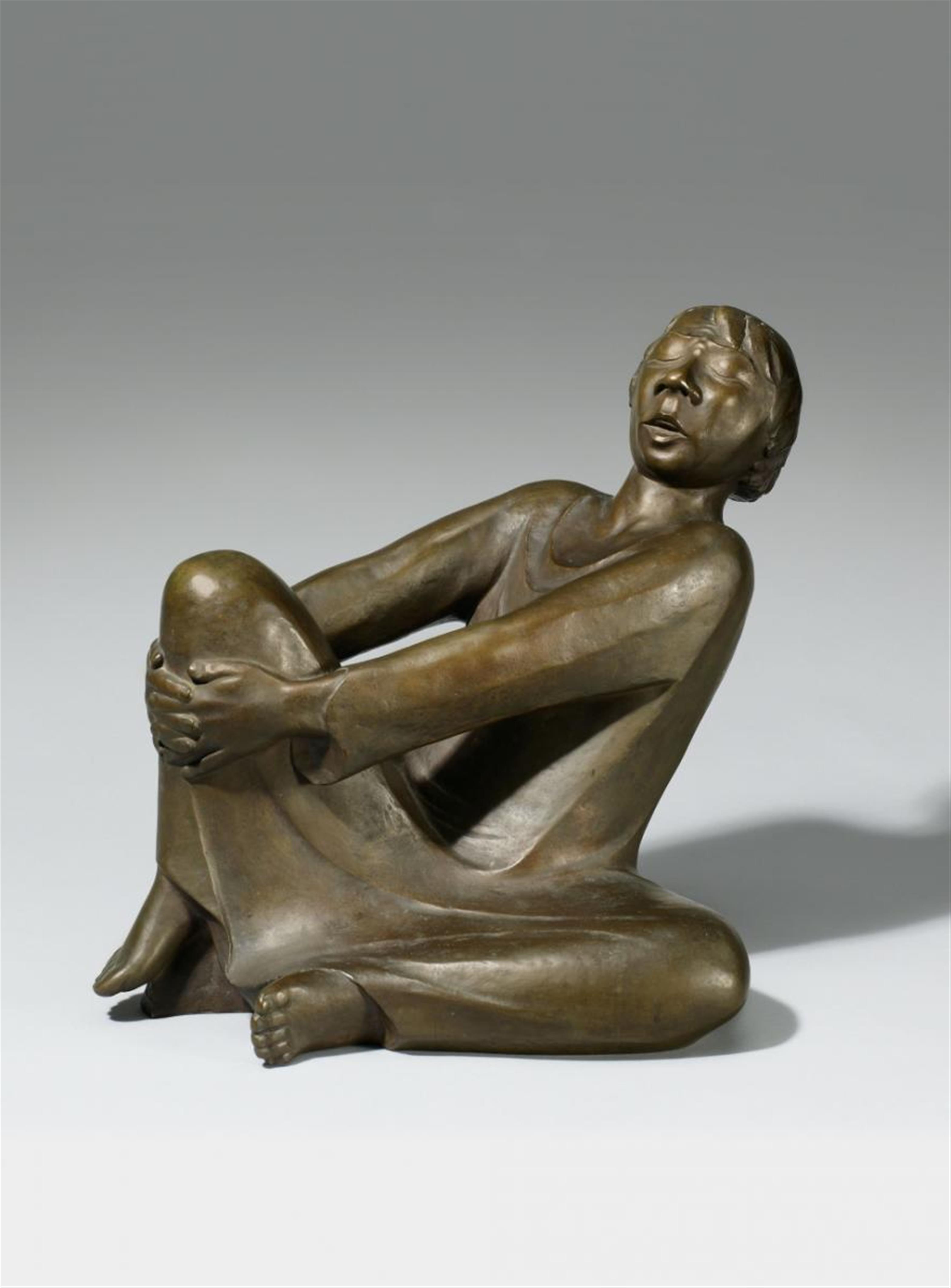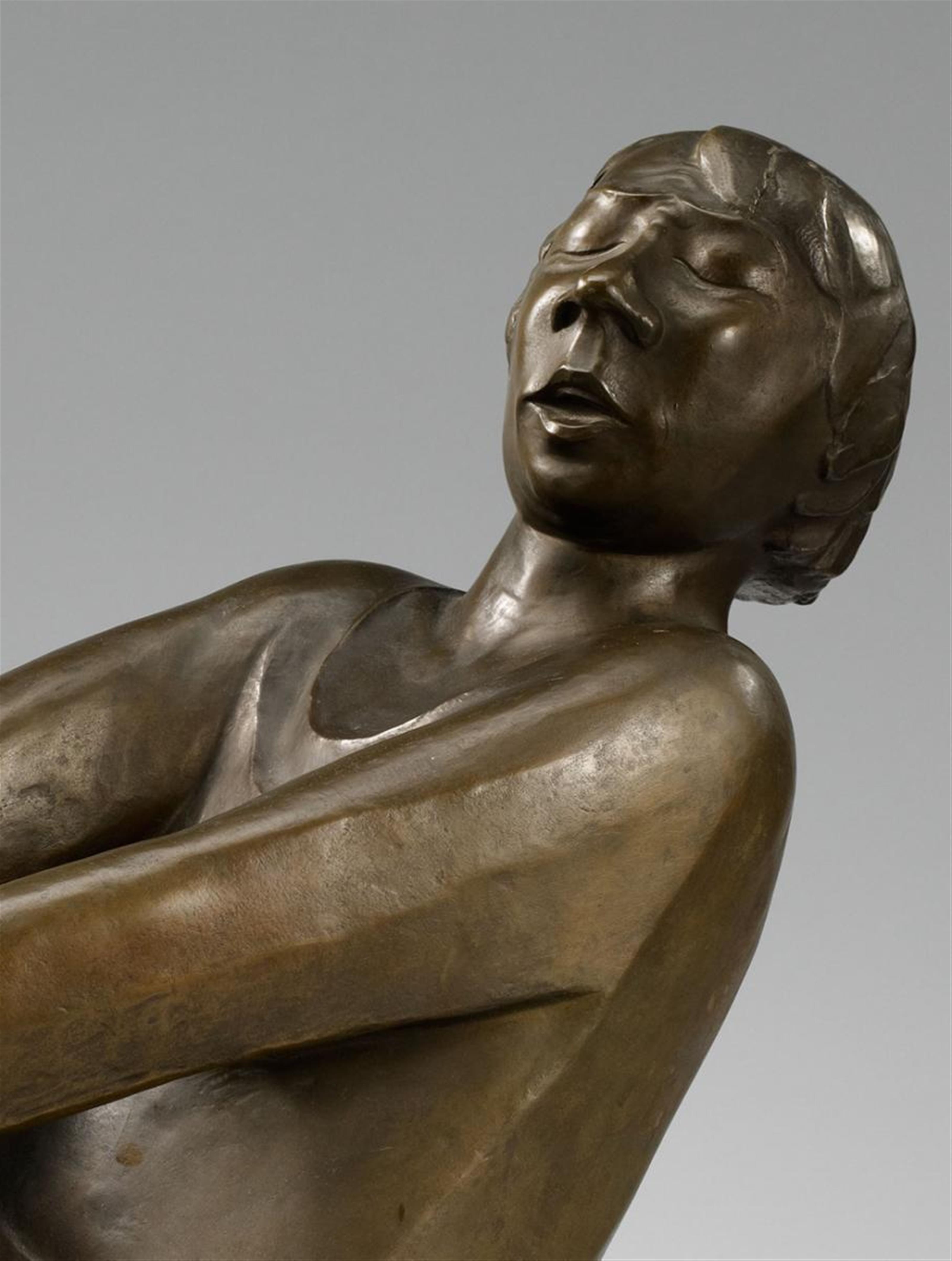Ernst Barlach
Der singende Mann
1928 (cast 1930/1931)
Bronze Height 49.5 cm Signed 'E.Barlach' and with the stamped numeration to lower right of the hem, and with foundry stamp "H. NOACK BERLIN FRIEDENAU" to the back edge. Cast 8/10. One of presumably 16 lifetime casts all in all. Laur only mentions one nummbered cast known of (4/10) in private possession. Edition Flechtheim (with fragmentary label to the interior). - Very fine bronze patina with an olive-coloured tinge.
This bronze sculpture - probably Barlach's most famous piece - illustrates his rare early Flechtheim casts from the Noack sculpture foundry in the Friedenau district of Berlin. In 1926, after the death of Barlach's friend Paul Cassirer, the artist's interests came to be represented by the art dealer Alfred Flechtheim who was based in Berlin and Düsseldorf. Although Flechtheim had his own financial problems, he supported Barlach in building a new studio in Güstrow, in the province of Mecklenburg. The two therefore concluded an agreement on 14 July 1930, planning to cast 20 different models of the years between 1907 and 1930. “Der singende Mann” was initially planned in ten copies which were subsequently realised by 1931. As Barlach's works met with great interest, his casts sold quickly, and six further copies were made in his lifetime. The fragmented but otherwise very typical label on the inside wall of the sculpture indicates that our cast is indeed a copy of the much coveted early Flechtheim series. They were exhibited at Flechtheim's galleries in Berlin and Düsseldorf in November and December 1930. For the general public the exhibition came as a minor sensation, because the artist was more widely known for his wood sculptures. Due to a major change in the political climate, the positive public response to Barlach however soon turned into the opposite.
After the war the Noack foundry stopped using the “Friedenau” stamp which had been a distinctive feature of the artist's early casts. Numbered casts - as in our bronze - were quite rare. The numerations of the older casts are stamped as fractions, i.e. with a horizontal line. This copy of “Der singende Mann” has been peened and created in a sand-casting process, characteristic of the early casts. The glittery-grey moulding sand that can be found like plaque on the inner walls is typical and was used frequently at Noack's sculpture foundry. Two features that are particularly beautiful about this copy are the hands and feet, elaborated in some detail, and the sculpture's patina which verges on olive green and is the result of a salted vinegar bath prior to patination.
“Der singende Mann” is considered to be one of the most important sculptures in German Expressionism. A young man is seated on the ground, singing fervently while clutching his right knee, his angled left leg lying on the ground. The resulting three-dimensional triangular composition, the posture of the figure, leaning back, and the closed eyes serve to emphasise the expressive, contemplative character of this bronze sculpture. The composure must be seen as an expression of a certain spiritual introspection, and the facial features of “Der singende Mann” are calm and serene.
“Der singende Mann” is the sole numbered cast of the early Flechtheim edition being offered for auction since the last few decades. This makes it especially rare.
Catalogue Raisonné
Laur 432; Schult I 343
Certificate
We would like to thank Hermann Noack sen., Berlin, for his kind confirmatory information dated 8 October 2014. We would also like to thank Elisabeth Laur, Hamburg, and Ernst Barlach, Ratzeburg, as well as Ernst-Barlach-Stiftung, Güstrow, for their additional information.
Provenance
Galerie Alfred Flechtheim, Berlin (with a fragmentary, partly blackened label with handwritten inscription in ink to the interior); acquired there circa 1930/31, since then in family possession
Literature
Alfred H. Barr, Omnibus, German Sculpture, Berlin/Düsseldorf 1932, p. 38-42; Marguerite Devigne, Ernst Barlach, in: Les Beaux-Arts, Brussels 1935, p. 14; Ernst Barlach, Ein selbsterzähltes Leben, Munich 1948, illus. 69; Carl Dietrich Carls, Ernst Barlach. Das plastische, graphische und dichterische Werk, 5th ed. Flensburg/Hamburg 1950, p. 58; Friedrich Schult, Ernst Barlach, Potsdam 1950, p. 40; Wolfgang Gielow, Ernst Barlach. Katalog der Plastik, Munich 1954, no. 252b; Paul Fechter, Ernst Barlach, Gütersloh 1957, p. 35; Wolf Stubbe/Friedrich Hewicker, Ernst Barlach Plastik, Munich 1959, p. 68 f.; Friedrich Schult, Ernst Barlach. Das Plastische Werk, Hamburg 1960, no. 343; Franz Fühmann (publ.), Ernst Barlach. Das Wirkliche und Wahrhaftige, Wiesbaden 1970, p. 159; Bestandskatalog Skulptur-Plastik-Objekt, Kunsthalle Mannheim, Mannheim 1982, p. 65, no. 440; Kunst des 20. Jahrhunderts, Museum am Ostwall, Dortmund 1984, p. 16 f.; Meisterwerke des Expressionismus und der Klassischen Moderne, Museum am Ostwall, Dortmund 1985, p. 32 f.; Ulrich Bischoff (ed.), Katalog der Bildwerke aus dem Besitz der Kunsthalle zu Kiel, Rendsburg 1986, p. 30 f.; Siegfried Gohr (publ.), Museum Ludwig Köln. Gemälde, Skulpturen, Environments vom Expressionismus bis zur Gegenwart. Bestandskatalog, Cologne 1986, p. 19; Georg Syamken (ed.), Die Dritte Dimension. Plastiken, Konstruktionen, Objekte. Bestandskatalog der Skulpturenabteilung der Hamburger Kunsthalle, Hamburg 1988, p. 92; Heinz Spielmann (ed.), Stiftung und Sammlung Rolf Horn, 2nd ed., Schleswig 1995, no. 120; Anita Beloubek-Hammer, Ernst Barlach, Plastische Meisterwerke, Leipzig 1996, p. 116 f.; Helga Thieme, Ernst Barlachs Skulptur "Der singende Mann" in der Ausstellung "Neue deutsche Kunst", Oslo 1932, in: exhib. cat. Rostock 1998, p. 310 ff.; Peter Thurmann, Zwei Holzbildwerke von Ernst Barlach und der Kulminationspunkt seiner Bildhauerkunst, in: Entdeckungen in der Hamburger Kunsthalle. Essays zu Ehren von Helmut R. Leppien, ed. by Uwe Schneede (publ.), Hamburg 1999, p. 60-64; Ulrich Großmann (publ.), Ursula Peters (ed.), Kulturgeschichtliche Spaziergänge im Germanischen Nationalmuseum. Die Sammlung zum 20. Jahrhundert, Nuremberg 2000, p. 83; Sabine Fehlemann (publ.), Ursula Frank (ed.), Von der Heydt-Museum Wuppertal, Skulpturensammlung. Neuauflage des Bestandskataloges von 1987, Wuppertal 2000, p. 32; Elisabeth Laur, Der Bildhauer als Buchkünstler, in: cat. Bremen 2001, p. 29; Jürgen Doppelstein/ Heike Stockhaus (ed.), Ernst Barlach. Mystiker der Moderne, exhib. cat. Ernst Barlach Gesellschaft Hamburg, Hauptkirche St. Katharinen, Hamburg 2003, p. 201; Ursel Berger/ Klaus Gallwitz/ Gottlieb Leinz (publ.), Posthume Güsse. Bilanz und Perspektiven, Berlin/Munich 2009, p. 32 f., p. 106 f.
Exhibitions
I.a.: Berlin/Düsseldorf November 1930 (Galerie Flechtheim), Bronzen von Ernst Barlach, exhib. cat. no. 19; Dresden 1931 (Galerie Ernst Arnold), Bronzen von Ernst Barlach; Oslo/Copenhagen/Cologne 1932, Nyere Tysk Kunst, cat. no. 6; Düsseldorf 1951 (Galerie Vömel), Ernst Barlach, no. 51; Recklinghausen 1963 (Städtische Kunsthalle Recklinghausen), Kunstwerke aus drei Jahrtausenden gesammelt im Ruhrgebiert, cat. no. 68; Hamburg 1977 (Ernst Barlach Haus), Stiftung Herrmann F. Reemtsma, Plastiken, Handzeichnungen und Autographen, ed. by Isa Lohmann-Siems, Gunhild Roggenbuck, cat. no. 53; Bergen/Güstrow 2000 (Bergen Kunstmuseum/Ernst Barlach Stiftung Güstrow), Ernst Barlach. Ein Graphiker und Bildhauer des deutschen Expressionismus, publ. by Helga Thieme, ed. by Elisabeth Laur, no. 92; Munich 2001 (Galerie Thomas), Ernst Barlach Plastiken, unpag.; Kyoto 2006 (The National Museum of Modern Art/The University Art Museum/Yamanashi Prefectural Museum of Art, Kofu), Ernst Barlach Retrospektive, no. 145






